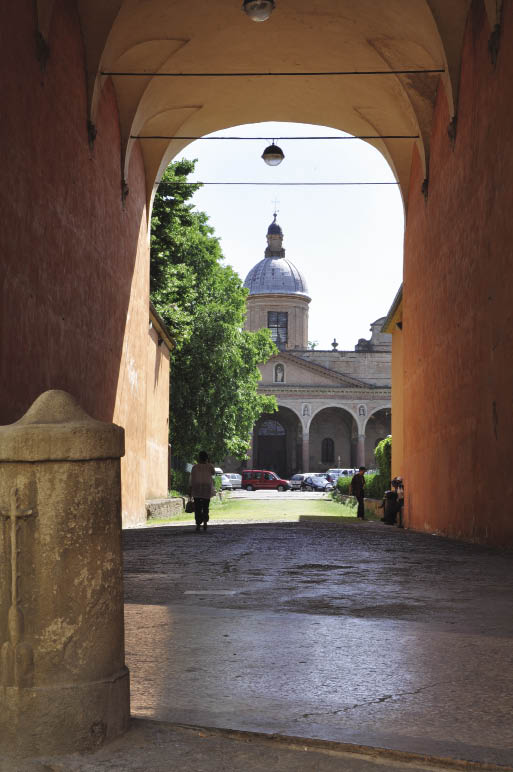The green treasure of Bologna is found behind gates, at
the back of brightly lit open galleries or in narrow halls, protected by
gates more or less imposing or old rickety and faded wooden
doors.
Surprisingly often, in fact, almost always, it is, whatever its
dimensions, the "family's heritage". It was done for the pleasure or the
necessity of the dwellers of the palace or the house, whether modest or
even crumbling.
These flower or vegetable gardens hidden behind
Bologna's buildings and homes represent a true wealth, from an aesthetic
and botanical point of view. They are open spaces that
convey preferences, skilfulness and poetry.
As part
of an exhibition dedicated to Bologna's historical centre, in 1970, Renzo
Renzi noted that, following Renaissance and Baroque expansion, within the
urban structure is a system of beautiful flower and vegetable gardens,
embellished by pictorial and architectural surroundings, curved porticos
with benches, alcoves and niches, statues, fountains and wells, crosswalk
surfaces made of various components, typical high walls between buildings,
luxuriant and exotic plant species.
Under the porches of "popular"
streets, at the end of long and dark entrance passages, there are
vegetable gardens created in the centre of two rows of terraced houses
facing parallel streets.
Two meaningful accounts describe these "common
gardens in poorer Bologna": Carlo Doglio refers to the modest, poor homes
with pathways of plants and greenery, the wealth of poorer Bologna
described by Bacchelli, Giuseppe Raimondi, Morandi.
Franco
Cristofori in Bologna Magra (1963) describes the small but poetic
space of the courtyard of the home he lived in as a child: "it was a small
courtyard with geraniums, the flowers of the poor, planted in tins aligned
along the walls; the pale blue wisteria clutched to the blacksmith's shed,
clothes hanging to dry on a rusted metal cable."
An intimist
description of a small "green" plot created with simple plant species,
almost always a vegetable garden for the food necessities of the family:
flowerbeds with parsley, lettuce, mint and reeds holding up tomato plants,
green peas and string beans.


Incidentally, where did the green pomegranate with its
beautiful bright red flowers grew? In the quiet and solitary garden of a
home in the popular Broccaindosso street.
It is true that these green
islands, protected (often hidden) by low or massive walls or even only by
metal fences, can be found in Bologna's urban centre in conventual areas:
the gardens of San Procolo, the gardens of the Baraccano Conservatory,
those of San Giacomo; those, recent, of Corpus Domini, Servi, SS
Salvatore, the cloisters of San Francesco and those of San
Mattia.
Green patches are unexpectedly found in old Bologna,
between stones and limestone, the cracks of walls, plaster
peelings. Weeds of the courageous type satisfied with the seeds carried by
the wind and a handful of soil, a little sun and a few rain drops. Modest
plants, obviously, parietaria or pellitory. In the many small gardens
between the centre and the outskirts of the city, it is easy to find
blackberry shrubs and dog roses, hawthorn bushes, clematis and common
buckthorn, cherry laurel, honeysuckle and boxwood. Ivy is found everywhere
and so is wisteria and lilac in small and well-tended private
gardens.
In 1937, the famous Bolognese painter, Nino Bertocchi,
wrote about the old and moral tradition of the interior gardens in
Bologna's homes, considering that they complement and soften the severity
of our architecture.
In the centre of Bologna, the fašades of elegant
and modest homes hide in general in their backyards a "green
heart", more or less sizable, prestigious or modest, because it is clear
that few people have the means and the space to create gardens that
respect the guidelines and principles provided by Bolognese Pier de'
Crescenzi (1230-1321) who, in his agricultural treatise entitled
Ruralium commodorum libri XII wrote clear and detailed rules for
the creation of home gardens in the city and in the country: the garden,
for medicinal oils; the viridarium, with cypresses, olive trees, laurels
and pine trees for wild animals; the pomario, an orchard dedicated to the
cultivation of varieties of fruits; the fish ponds and the aviaries; the
meadows; and the small irrigation canals.
Along the streets
Maggiore, Santo Stefano, Castiglione, Saragozza, Galliera, there are
unexpected and surprising green interiors, also along the streets
Solferino, Orfeo, Mirasole, Santa Caterina, they are revealed as a
comprehensive and authentic evidence of the culture of living.